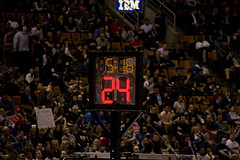Using the Shot Clock with Purpose

Being able to have good Shot Clock management is something many coaches see as a secondary element to a team’s offense and execution. When broken down however examining the phases of offense and desired shots in line with the shot clock can be an invaluable exercise in helping to improve the basketball intelligence of a team.
Every team has a variety of phases to their offense. Some of these phases will be more utilised then others. The hope from well-drilled and proficient teams is they can more through each phase succinctly and deliberately looking for the best possible scoring opportunity. The end goal should always be to have the right shot at the right time for the team.
The phases of offense are:
- Fast Break
- Primary Transition
- Secondary Transition
- Half-Court Offense
- Terminal Offense
The different phases and their importance to a team will be heavily based a coaches philosophy. The tragedy in this situation is that a coach not strong in any one particular phase will ultimately undervalue or limit the ability for a team to fully develop in this area. This is why constant revision, evaluation, and reflection are important in a coaches array of tasks to be completed on a regular basis so weaknesses can be identified and consolidated with training and development.
The Fast Break Phase is the immediate option once the ball is secured through a turnover or stoppage. A fast break while still possible is not the immediate option following a made basket as the offense should slot into the structured offensive choice such as their primary transition. Because this option is about pace, intensity and effort the timing in regards to the shot clock should happen within three to five seconds.
Good primary transition play will reflect principles or the philosophy of a team’s fast break. This will ensure the primary transition and fast break option always re-enforce each other rather than being two stand-alone options. The Primary Transition Phase will last between three to five seconds on the shot clock. This is the same length of time as a fast break, if you have not realised yet either one or the other will be utilised in moving the ball from one end of the court to the other.
The Secondary Transition Phase can happen after either a fast break or when the primary transition is executed. For many teams the secondary transition is a series of quick hitter scoring opportunities that set the team for their main scoring focus of the half-court offense. The secondary transition therefore should not be longer than three to four seconds of the shot clock.
These three phases should not change depending on what the rules are for your competition for shot clock length. In College or FIBA rules regulated competitions the fast break, primary transition and secondary transition phases should be heavily focused on advancing the ball with a purpose of scoring. Also, waste as little time as possible in the process of shifting the ball from one end of the floor to the other.
The Half-Court Offense Phase for many teams will be their main scoring period. For teams using a thirty-five second shot clock this phase can be up to twenty-six seconds in length. That sounds like a very long time and it is. Most teams never reach this level of efficiency to be able to spend this time in the half court due to slower times in the lead-up phases (e.g. transition).
For team playing with a twenty-four second shot clock the half-court offense phase will hold a period of up to thirteen seconds in duration. The differences in playing style are evident if you compare the two different shot clock periods, as too the complexity to the offense movements possible within this time.
In some coaching systems or coaches’ philosophy, they will not utilise a terminal set to finish the offensive period. In these situations the team continues to run the half-court offense until a shot presents itself. Hopefully the shortcomings of this type of thinking are obvious but this is still a widely implemented strategy.
The Terminal Offense Phase is conducted when the half-court offense fails to provide an adequate scoring opportunity. This phase will occur when the shot clock is at six seconds or less. The current trend across the globe is for the terminal offense phase to feature a two-man game usually an on-ball screen or hand-off.
The times discussed in these phases should be a starting point for analysis of your own team’s style of play. As coach, being aware of how your teams various phases fit together will go a long way in helping you find solutions to problems concerning output. Try to avoid however having excessively long primary and secondary transition or terminal offense phases.
Another variation, which will affect the length of time spent in each phase, will be what constitutes a good shot for the team. Teams that look for three-point shooting opportunities early will spend less time in each phase.
So if your team is not spending long in a particular phase should you be concerned as a coach? It depends on the scoring rate and efficiency of your team. The important thing to realise is teams that have a game plan or purpose within in each phase will be a more complete team that is able to better deal with the changes that happen in a game. Teams that than also have an awareness of the shot clock and how this fits within their style of play again become more and more adaptable and dynamic in how they can deal with the pressures of competition basketball.




